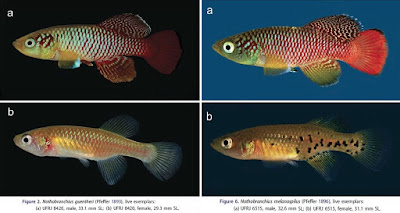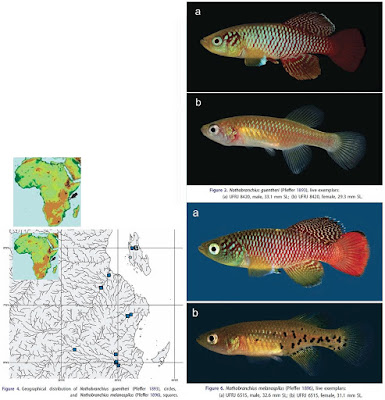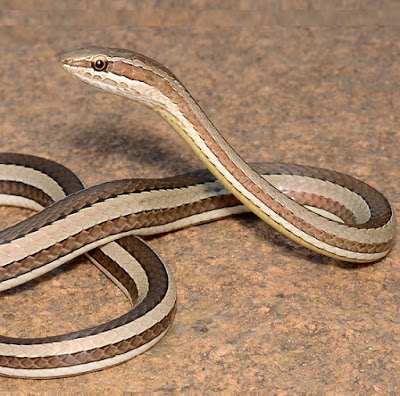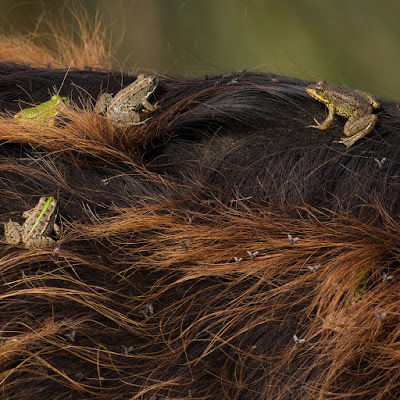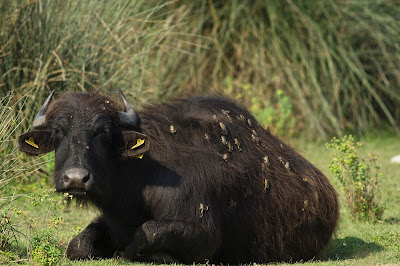[Most Recent Entries] [Calendar View]
Sunday, August 20th, 2017
| Time | Event | ||||||
| 3:33a | [Ichthyology • 2017] Taxonomic Revision of the Seasonal Killifish Genus Nothobranchius (Cyprinodontoidei: Aplocheilidae) from Zanzibar, East Africa ABSTRACT Nothobranchius guentheri and Nothobranchius melanospilus, the two seasonal killifishes of the genus Nothobranchius occurring in Zanzibar Island, Tanzania, were involved in past taxonomical mistakes and are still misidentified in museum collections. A historical review is herein presented and both species are redescribed on the basis of type material and recent collections. Nothobranchius guentheri, a popular aquarium fish, is endemic to Zanzibar, and N. melanospilus, geographically widespread in East Africa, occurring both in Zanzibar and in continental river basins. These species are distinguished by a series of morphological features not previously reported in the literature, including pre-dorsal length and relative position of the anterior portion of the dorsal-fin skeletal support and vertebrae; number of gill-rakers of the first branchial arch, caudal-fin rays, scales of the longitudinal series, series of scales around caudal peduncle, and vertebrae; frontal squamation; and arrangement and number of neuromasts of the supraorbital series. The present taxonomic revision comprising N. guentheri and N. melanospilus, the oldest species names of the genus in the East African biodiversity hotspot, is important to improve the knowledge of the genus in a region where its taxonomy is still problematic KEYWORDS: Biodiversity hotspot, East African coastal forests, systematics, Unguja Island Wilson J. E. M. Costa. 2017. Taxonomic Revision of the Seasonal Killifish Genus Nothobranchius from Zanzibar, East Africa (Cyprinodontoidei: Aplocheilidae). Journal of Natural History. 51(27-28); 1069-1624. DOI: 10.1080/00222933.2017.1330976 | ||||||
| 2:36p | [Herpetology • 2017] Records of the Indian Sand Snake Psammophis condanarus (Merrem, 1820) (Reptilia: Lamprophiidae) in southern India
Abstract We present new records of the Indian Sand Snake Psammophis condanarus from southern India, where its existence has remained doubtful till date. Our records are based on both live and preserved voucher specimens that are illustrated and described here. We furnish distribution records of this species from two sites belonging to two different ecoregions in southern India—Tirupati in the Eastern Ghats and Hospete in the Deccan plateau. Our work highlights the obscurity of certain, large-growing, diurnal land snakes that have as yet managed to evade the attention of field biologists largely due to a lack of field surveys in certain ecoregions. Keywords: Distribution, literature records, snake, southern India. Psammophis condanarus (Merrem, 1820) Coluber condanarus Merrem, 1820 Leptophis bellii Jerdon, 1854 Psammophis taeniata Günther, 1862 Psammophis indicus Beddome, 1863 Phayrea isabellina Theobald, 1868 (inc. sed. fide Wall 1921) Psammophis sibilans quadrilineata Jan, 1870 in Jan & Sordelli, 1866–1870 Mike elegantissima Werner, 1924 Psammophis condanarus condanarus - Smith 1943 Taphrometopon condanarum - Wallach et al. 2014 S.R. Ganesh, Vivek Sharma and M. Bubesh Guptha. 2017. Records of the Indian Sand Snake Psammophis condanarus (Merrem, 1820) (Reptilia: Lamprophiidae) in southern India. Journal of Threatened Taxa. 9(7); 10453-10458. DOI: 10.11609/jott.3468.9.7.10453-10458 | ||||||
| 2:43p | [Ecology • 2017] A Possible Mutualistic Interaction Between Vertebrates: Frogs (Pelophylax ridibundus) Use Water Buffaloes (Bubalus bubalis) As A Foraging Place
Abstract Mutualisms shape biodiversity by influencing the ecology and the evolution of populations and communities. For example, among many others, birds commonly forage in association with large mammals, including livestock, but so far no similar relationship has been described for amphibians. In this note we describe the association between the Marsh Frog (Pelophylax ridibundus) and the Anatolian Water Buffalo (Bubalus bubalis) in Turkey and provide possible explanations for the existence of direct relations between these representatives of two vertebrate classes. We hope that our note stimulates future research on this subject. Keywords: Bubalus bubalis, interaction, Pelophylax ridibundus.
Piotr Zduniak, Kiraz Erciyas-Yavuz and Piotr Tryjanowski. 2017. A Possible Mutualistic Interaction Between Vertebrates: Frogs Use Water Buffaloes As A Foraging Place. Acta Herpetologica. 12(1); 113-116. DOI: 10.13128/Acta_Herpetol-20574 Frogs Hitch Ride on Water Buffalo—Never Before Seen on.natgeo.com/2vKJqd9 @NatGeo |
| << Previous Day |
2017/08/20 [Calendar] |
Next Day >> |

